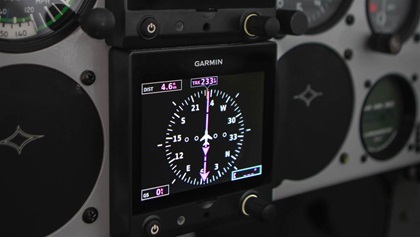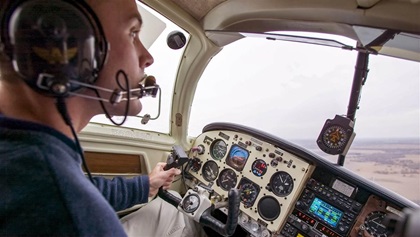You're on the air
Radio proficiency is within your grasp

Others use the airwaves as a personal chat line. Your goal is to find the comfortable happy medium that lets you communicate clearly and concisely and will work for you and air traffic control.
Talking on the radio feels unnatural to many pilots. This style of communication is unfamiliar. It’s somewhat rigid, at least compared to everyday freeform conversation. It utilizes a new vocabulary; heck, it utilizes a different way of pronouncing the alphabet. It’s not how we communicate when driving a car. There, we use turn signals, lights, horns, the occasional wave, and the (hopefully infrequent) rude hand signal.
Fortunately, pilots have a primer for good radio communications, and it’s called the Pilot/Controller Glossary, which is in the Aeronautical Information Manual—that part of the book that’s bundled with the federal aviation regulations as the FAR/AIM. The glossary defines the many aviation phrases you’ll learn, including two of the most important ones: “say again” (I didn’t hear you or I didn’t understand you) and “unable” (I heard your instruction, but I can’t do that right now).
Every radio call has a specific function: to convey or extract information. You could be talking to a single person in another airplane; an air traffic controller; or a general area covered by a single common traffic advisory frequency, which might encompass one or more airports.
Radio calls should be concise and follow a format.
Every radio call starts the same way: Name of the facility you are calling, your identification (the airplane’s full N number), and your location.
From there the components vary, but only a little. At a nontowered airport, you are most likely announcing your intentions (to taxi to or depart on a runway, remain in the pattern, your position in the pattern) to all who are monitoring your airport’s common traffic advisory frequency. You may get a response from another aircraft, but mostly the conversation at a nontowered airport is one-sided. You are conveying information.
At a towered airport, the conversation is two-sided. For starters, on the surface at a towered airport, you will relay your position to a ground controller. When the controller acknowledges you, you make your request or give your information. You will have to do the same thing—announce your position—when approaching a towered airport in the air.
A shorthand way of remembering this format is: Hey you; it’s me; (I am here); Here’s what I am doing (or, here’s what I need). The AOPA Air Safety Institute’s online course Say It Right: Mastering Radio Communications refers to the four Ws: Who am I, who are you, where am I, and what do I want. See the full course online (airsafetyinstitute.org/courses/sayitright).
From there, your transmissions are simply continuations of that conversation, where you acknowledge and adhere to the controller’s instructions, or the controller provides the guidance you have requested. Thus, it is a two-sided conversation, where information is exchanged, and instructions are given and received.
Strive for consistency and brevity in your radio communications. At the same time, acknowledge that in the early stages of pilot training your radio calls will be a little rough. To your ears, they may sound downright embarrassing. That’s OK. You will get better at talking on the radio the more you practice it.
Training at a nontowered airport, I had to give a position report when approaching the downwind leg of the pattern at a 45-degree angle. I could not keep the phrase “November One-Two-Three-Four is on a three-mile forty-five to the downwind of Runway Two-Three” in my brain, and would blurt various versions of that call, none of them correct. Finally, I wrote the phrase on a sticky note and put that on the instrument panel. After a few more lessons, the phrase made a groove in my memory and I didn’t need the sticky note.
The AIM stipulates that, as a student pilot, you can let the controller know you’re a student pilot by adding the term “student pilot” to the end of your initial radio call. This tells the controller, “Hey, I’m a newcomer. Please take that into account when talking to me.” The controller will give you any extra consideration or assistance that you need. Include the phrase “student pilot” in your transmissions as much as you need to. Once you become a private pilot, you won’t be able to use that trick.
Technique
The AIM preaches “Jargon, chatter, and ‘CB’ slang have no place in ATC communications.” Avoid jargon, chatter, and slang, but don’t despair if a stutter, an “uh,” or a nonstandard word creeps into a transmission once in a while. All pilots were once beginners at talking on the radio, and none of us came out of the womb sounding like Chuck Yeager.
Before keying the push-to-talk button on the microphone, take a deep breath. Listen for a break in the transmissions so that you do not talk over or “step on” someone else’s transmission.
Know what you want to say. Write it down if you need to, as I did with the “forty-five to the downwind to Runway Two-Three” call.

Ways to improve
Radio calls can be practiced at home, where no one will hear you but the dog, and he isn’t going to pass judgment. (The cat probably will.)
You can also listen to other pilots on a handheld radio. These work best when you’re at the airport, and you might find a kindred spirit on the next bench doing the same thing.
Know a pilot with a good radio style? Ask if you can ride right seat or backseat with them sometime and pick up the check for breakfast or lunch. Cheaper than a lesson!
You can listen to other pilots and air traffic controllers at almost any airport on LiveATC.net. This streaming website lets you tune in to both towered and nontowered airports, which is helpful because if you train at one and not the other, you’ll get a sense of how the other side works before you have to fly there.
For a more realistic experience that allows you to participate, you can subscribe to VatSim.com, where you will fly simulated flights and communicate in real time with people who are acting as air traffic controllers. This fee-based community is a fun way to experience flying in different parts of the nation—or the world.
The more you talk on the radio, the more comfortable you’ll be. As an instrument pilot, you’ll be in frequent contact with ATC. VFR pilots can gain some of the same benefits of working within the ATC system by filing and opening VFR flight plans or requesting VFR traffic advisories, which most people call “flight following.” I request flight following when possible because I like to listen to the effortless give-and-take between controllers and airline pilots—and the occasional goof, which reminds me that nobody’s perfect.



 ‘Any traffic in the pattern, please advise’
‘Any traffic in the pattern, please advise’

